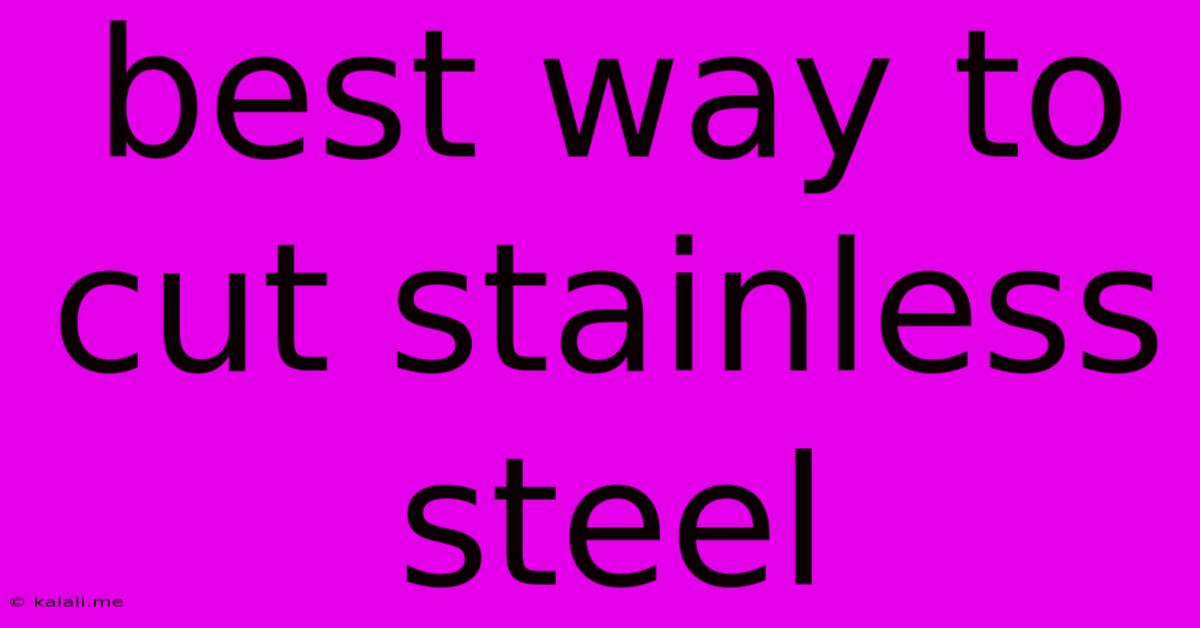Best Way To Cut Stainless Steel
Kalali
May 30, 2025 · 4 min read

Table of Contents
The Best Ways to Cut Stainless Steel: A Comprehensive Guide
Cutting stainless steel can seem daunting, but with the right tools and techniques, it's a manageable task. This guide will walk you through the best methods, considering factors like material thickness, desired cut quality, and available resources. Whether you're a seasoned fabricator or a DIY enthusiast, understanding these techniques is crucial for achieving clean, precise cuts.
Choosing the right method depends heavily on the thickness of the stainless steel and the desired finish. For thin sheets, certain methods are far more practical than for thicker plates. We'll explore the various options, highlighting their strengths and weaknesses.
Understanding Stainless Steel's Properties
Before diving into cutting methods, it's important to understand the properties of stainless steel that affect the cutting process. Its hardness and tendency to work-harden (becoming harder with each cut) make it more challenging to cut than other metals. The presence of chromium, which provides its corrosion resistance, also impacts the cutting process, potentially leading to tool wear if not handled correctly.
Top Methods for Cutting Stainless Steel
Here's a breakdown of the most effective methods for cutting stainless steel, categorized by material thickness and desired outcome:
1. Shearing (For Thinner Sheets):
- Best for: Thin sheets (up to 6mm or 1/4 inch)
- Method: Shearing uses a powerful press to cleanly cut through the material. It produces a relatively straight, burr-free edge, making it ideal for precision work. This is often done industrially, but smaller hand-operated shears exist for thinner gauge materials.
- Pros: Clean cut, minimal burrs, efficient for thin materials.
- Cons: Requires specialized equipment, not suitable for thicker materials.
2. Abrasive Cutting (For Various Thicknesses):
- Best for: A wide range of thicknesses, particularly for curved cuts or intricate shapes.
- Method: This involves using an abrasive wheel, like those found on angle grinders or chop saws. Coolant is crucial to prevent overheating and work hardening.
- Pros: Versatile, can handle various thicknesses, good for complex shapes.
- Cons: Can produce heat-affected zones, requires safety precautions (eye protection, gloves, etc.), can create burrs.
3. Plasma Cutting (For Thicker Materials):
- Best for: Thicker materials (above 6mm or 1/4 inch) and complex shapes.
- Method: Plasma cutting uses a high-velocity jet of plasma to melt and sever the material. It produces a relatively clean cut, but some edge preparation might still be needed.
- Pros: Fast, efficient for thicker materials, accurate cuts, good for intricate shapes.
- Cons: Requires specialized equipment, can produce fumes, safety precautions are essential.
4. Laser Cutting (For High Precision):
- Best for: High-precision cuts, intricate designs, and thin to medium thickness materials.
- Method: Laser cutting uses a focused laser beam to vaporize the material, producing very clean, precise cuts.
- Pros: Extremely precise, clean cuts, minimal heat-affected zones, excellent for intricate designs.
- Cons: Expensive equipment, not always suitable for very thick materials.
5. Waterjet Cutting (For Various Materials and Thicknesses):
- Best for: A wide range of thicknesses and materials, even those that are difficult to cut with other methods.
- Method: Waterjet cutting uses a high-pressure stream of water mixed with an abrasive to cut through the material. It's very versatile and creates a clean cut.
- Pros: Versatile, clean cuts, minimal heat-affected zones, can cut various materials.
- Cons: Can be slower than other methods, potentially more expensive.
6. Hand Sawing (For Small Jobs and Specific Cuts):
- Best for: Small, intricate jobs where precision is paramount.
- Method: This method requires a specialized hacksaw blade designed for stainless steel, along with a generous amount of cutting oil or lubricant. It's labor-intensive but allows for very fine control.
- Pros: Relatively inexpensive, good for small, precise cuts.
- Cons: Labor-intensive, slow process, requires skill and patience.
Safety Precautions
Regardless of the method you choose, safety should always be the top priority. Always wear appropriate personal protective equipment (PPE), including safety glasses, gloves, and a respirator if necessary. Ensure adequate ventilation when using methods that produce fumes or dust.
Choosing the Right Method
The best way to cut stainless steel depends on several factors: the thickness of the material, the complexity of the cut, the desired finish, and the available tools and equipment. Weigh the pros and cons of each method before making your choice. For many DIY projects, abrasive cutting might be suitable, while industrial applications may benefit from laser or plasma cutting. Remember that preparation and proper technique are key to achieving a successful and safe cut.
Latest Posts
Latest Posts
-
How To Redefine A Valu In A Set
May 31, 2025
-
How Many Amps Does A Ceiling Fan Use
May 31, 2025
-
What Is A Single Outlet Circuit
May 31, 2025
-
Is It Normal For Water To Come Out Of Exhaust
May 31, 2025
-
My Car Is In The Garage
May 31, 2025
Related Post
Thank you for visiting our website which covers about Best Way To Cut Stainless Steel . We hope the information provided has been useful to you. Feel free to contact us if you have any questions or need further assistance. See you next time and don't miss to bookmark.